
Skin care
Skin care
peer-reviewed
The role of plant peptidomics and protemics in advanced skin and hair care
ÒSCAR EXPÓSITO*, MONIKA BUCHHOLZ, ALEJANDRO GUIRADO, ANA GALLEGO, SANDRA RUIZ, MARIA MAS, PAU RIERA, DANIEL LUNA, SARA LAPLANA, TARIK RUIZ, LAURA FACCHINI, MARTA GIBERT, LAURA CANO
*Corresponding author
Vytrus Biotech S.A. Terrassa, Barcelona, Spain
ABSTRACT: The cosmetic peptide industry relies heavily on costly, transgenic human-derived peptides. Plant biotechnology presents a sustainable alternative, revealing peptides that mimic regenerative mechanisms of animal cells. Utilizing patented Phyto-Peptidic Fractions from Centella asiatica and Curcuma longa stem cells, our research identifies peptides with strong potential for skin and hair regeneration. These plant-derived oligopeptides exhibit activity analogous to growth factors, based on sequence homology, supporting tissue repair and anti-aging effects. Their bioactivity, sustainability, and clinical validation position them as a promising natural alternative to synthetic peptides, offering a significant advancement in cosmetic science through the application of advanced peptidomics and proteomics.
??????????????????
“
“A study in healthy women providing probiotic yogurt for four weeks showed an improvement in emotional responses as measured by brain scans”
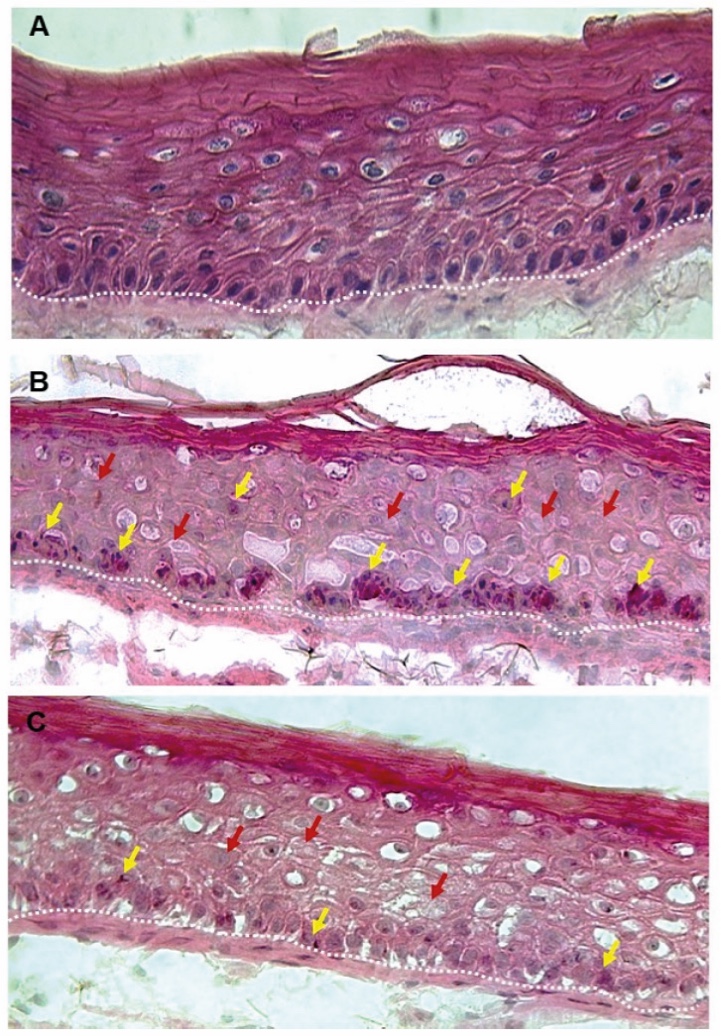
Figure 1. Skin Section with Microbiome. Most microorganisms live in the superficial layers of the stratum corneum and in the upper parts of the hair follicles. Some reside in the deeper areas of the hair follicles and are beyond the reach of ordinary disinfection procedures. There bacteria are a reservoir for recolonization after the surface bacteria are removed.
Materials and methods
Studies of major depressive disorder have been correlated with reduced Lactobacillus and Bifidobacteria and symptom severity has been correlated to changes in Firmicutes, Actinobacteria, and Bacteriodes. Gut microbiota that contain more butyrate producers have been correlated with improved quality of life (1).
A study in healthy women providing probiotic yogurt for four weeks showed an improvement in emotional responses as measured by brain scans (2). A subsequent study by Mohammadi et al. (3) investigated the impacts of probiotic yogurt and probiotic capsules over 6 weeks and found a significant improvement in depression-anxiety-stress scores in subjects taking the specific strains of probiotics contained in the yogurt or capsules. Other studies with probiotics have indicated improvements in depression scores, anxiety, postpartum depression and mood rating in an elderly population (4-7).
Other studies have indicated a benefit of probiotic supplementation in alleviating symptoms of stress. In particular, researchers have looked at stress in students as they prepared for exams, while also evaluating other health indicators such as flu and cold symptoms (1). In healthy people, there is an indication that probiotic supplementation may help to maintain memory function under conditions of acute stress.
Introduction
The oligopeptide industry, largely dominated by human-derived peptides, faces challenges due to transgenic and costly production processes, highlighting the need for non-transgenic, cost-effective, and scalable peptide production strategies (1, 2). Advanced plant biotechnology offers promising alternatives, as plants share many tissue regeneration processes with animals (3, 4). This study leverages patented Phyto-Peptidic Fractions (PPF) technology to introduce a new generation of biomimicking peptides derived from the secretomes of Centella asiatica (CA) and Curcuma longa (CL). This study presents new research on the bioactive properties of CA and CL secretomes. Our methodology pioneered the identification of proteins and peptides, through proteomics and peptidomics analyses, and created a comprehensive data base named PEPVYT, including extensive bibliographic review of previously described peptides of interest with cosmetic applications, exhibiting multifunctional properties such as anti-aging, tissue regeneration, and hair growth stimulation to further underscore the potential of plant-derived peptides as sustainable, robust alternatives to synthetic options (5, 6, 7, 8, 9).
Materials and methods
Centella asiatica and Curcuma longa cell cultures
Totipotent cell cultures of Centella asiatica and Curcuma longa were established in modified MS medium enriched with phytohormones and incubated in darkness under constant agitation to ensure high-density biomass. The cultures secreted peptide-rich exudates (secretomes), which were recovered by 100 µm filtration for further analysis.
Proteomics analysis
Protein Extraction and Preparation
Secretomes from both C. asiatica and C. longa were lyophilized and reconstituted in phosphate buffer before protein concentration via Speed-Vac. Total protein extracts were separated by SDS-PAGE and visualized using Coomassie Brilliant Blue staining. Selected protein bands were excised and subjected to standard in-gel digestion protocols, including reduction with DTT, alkylation with iodoacetamide, and enzymatic digestion using trypsin.
LC-MS/MS Analysis
Digested peptides were analyzed using reversed-phase liquid chromatography tandem mass spectrometry (RP-LC-MS/MS) performed on an Easy-nLC II system coupled to an LTQ-Orbitrap Velos Pro mass spectrometer. Peptide separation was achieved using a C18 analytical column and a 120-minute gradient of acetonitrile. The nano-electrospray ionization was set at 2.1 kV. Full MS scans were acquired at high resolution (400–1600 m/z), followed by 20 data-dependent MS/MS scans using collision-induced dissociation.
Protein Identification and Classification
Peptide spectrum matching and protein identification were carried out using PEAKS STUDIO XPRO (Bioinformatics Solutions Inc., Canada), searching against the Spermatophyta Uniprot database (UniProt release 02/2022). The decoy-fusion strategy was employed to ensure a false discovery rate below 1%. Protein classification was further conducted with the PANTHER DB (v17.0) based on Arabidopsis thaliana annotation models. The PEPVYT database was created through a combination of de novo peptide identification, literature curation, and functional classification using GENE ONTHOLOGY (GO) and PANTHER DB. Bioactivity annotations were inferred based on sequence similarity and domain function
Peptidomics analysis
Peptide Extraction and Preparation
The sample preparation and Instrumental analysis were performed by Creative Proteomics services (Creative Proteomics, NY, USA). Samples were diluted in 0.1% TFA and passed twice through ziptip columns. Following desalting, peptides were eluted with 60% acetonitrile, lyophilized to near dryness, and resuspended in 20 μL of 0.1% formic acid.
LC-MS/MS Analysis and Data Interpretation
Peptide analysis was carried out on an Ultimate 3000 UHPLC system coupled with an Orbitrap Q Exactive HF mass spectrometer. Chromatographic separation was achieved on a PepMap C18 column at 250 nL/min using a multistep acetonitrile gradient. Full MS scans were collected at 60,000 resolution, followed by Top 20 MS/MS scans at 15,000 resolution. Dynamic exclusion was set to 30 seconds. Sequence identification was conducted using PEAKS STUDIO 8.5, applying precursor mass tolerance of 10 ppm and fragment mass tolerance of 0.5 Da.
In vitro studies
Evaluation of senescent markers in Centella asiatica secretome
Human dermal fibroblasts (HDF) were cultured in serum-deprived conditions and treated with 0.01% C. asiatica secretome for 72 hours. Untreated cells (C−) and benchmark-treated cells (C+) were included as controls. Pro-collagen I and elastin levels in the culture supernatants were quantified using commercial ELISA kits (Human Pro-Collagen I and Elastin ELISA Kits, ABCAM, UK). All treatments were performed in triplicate.
Evaluation of anti-hair loss activity in Curcuma longa secretome
To evaluate the hair-regenerative potential of C. longa, HFDPC were cultured in collagen-coated plates and treated with serial dilutions of secretome (6.25, 3.125, and 1.56 μg/mL) for 24 and 48 hours. Cell proliferation was assessed using BrdU incorporation assays. For IGF-1 quantification, HFDPC were grown to confluence, serum-starved overnight, and treated with the same concentrations of C. longa secretome. IGF-1 levels were determined using a human ELISA kit (RayBiotech, GA, USA), and results were normalized against the negative control.
In vivo activities
Antiaging potential of the secretome of Centella asiatica
A double-blind, placebo-controlled trial was conducted with 20 women aged 51–59 years, who applied 2% C. asiatica secretome to the crow’s feet area twice daily for 28 and 56 days. Skin firmness and elasticity were measured using Cutometer® MPA-580 (Microcaya, Spain). Elasticity Rejuvenation Index (ERI) was calculated using Takema’s correlation model against a reference group of younger volunteers (20–25 years). Skin complexion was assessed using VISIA® imaging under standard light settings. Data were analyzed using paired t-tests and ANOVA, with significance set at p < 0.05.
Hair density and growth promotion by the secretome of Curcuma longa
A 150-day randomizedplacebo-controlled clinical study was performed in 40 participants (18–60 years) experiencing various forms of hair loss. Subjects were randomly assigned to treatment groups. The study was double-blinded. Subjects applied either placebo or 1% C. longa secretome daily. Hair growth was monitored using trichogram analysis and hair density was quantified by TrichoScan® (Tricholog GmbH, Germany), calculating hair count per cm² at baseline, 90 days, and 150 days.
Analysis of eyelash and eyebrow density increase
Volunteers applied C. longa secretome gel to eyelashes and eyebrows twice daily for up to 150 days. A validated photonumeric scale was used for density scoring: the Global Eyelash Assessment (GEA) and Global Eyebrow Assessment (GEBA), both ranging from 1 (sparse) to 4 (dense). Evaluations were conducted at predefined intervals.
Results
Protein characterization through advanced proteomics
Proteomic analysis of Centella asiatica revealed a rich secretion profile, comprising a total of 1,260 proteins within the culture medium. Among these, 126 proteins were uniquely identified using the Arabidopsis thaliana model as a reference through the PANTHER DB protein classification system (PANTHER 17.0, University of Southern California, USA) (11). The identified proteins demonstrate a broad functional repertoire, positioning C. asiatica secretome as a naturally diverse protein reservoir with multiple bioactivities relevant to skin biology (Figure 1).
The classification of C. asiatica proteins highlights several functional groups, including metabolite interconversion enzymes, protein-modifying enzymes, cytoskeleton-associated proteins, activity-modulating proteins, and chaperones (10, 12). Notably, metabolite interconversion enzymes were the most abundant, followed by a well-balanced representation of the remaining classes. These findings underscore a multifaceted protein profile that suggests potential applications in modulating cellular communication, wound repair and structural remodeling (15).
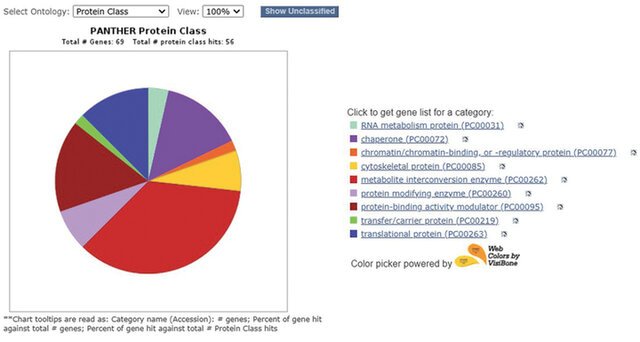
Figure 1. Protein characterization of Centella asiatica by means of PANTHER DB software. The study utilized the model plant Arabidopsis thaliana as a basis. Protein annotations were based on homology to Arabidopsis thaliana sequences.
A bibliographic review was conducted to explore the different functionalities that these groups of proteins can have. Specifically, for example, the group of metabolite interconversion enzymes was related to cell-to-cell communication functionalities and cytoskeleton proteins; activity-modulating proteins and chaperone groups can be related to wound healing, tissue regeneration, and cell-to-cell communication functionalities (Table 1)(16, 17, 18, 19, 20).
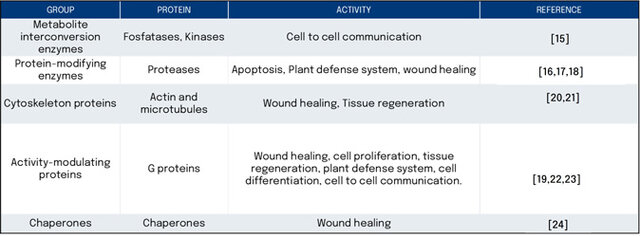
Table 1. Protein characterization of Centella asiatica and assignment of functionality. Functions were annotated via PANTHER DB and GO-TERM analysis, supported by literature references.
In parallel, the proteome of Curcuma longa secretome exhibited comparable complexity, comprising 1,050 total proteins with 105 distinct identifications using the same Arabidopsis-based PANTHER DB classification system (Figure 2).
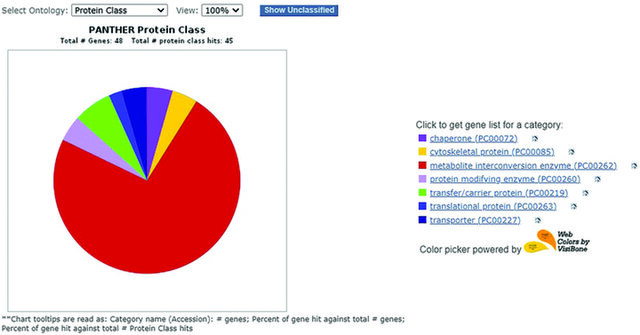
Figure 2. Protein characterization of Curcuma longa using PANTHER DB software. The study utilized the model plant Arabidopsis thaliana as a basis. Protein annotations were based on homology to Arabidopsis thaliana sequences.
From a functional standpoint, the C. longa secretome includes proteins with defined roles in cellular growth, defense signaling, and matrix remodeling. Functional assignments derived from the literature correlate with enhanced expression of growth factor-like activity, cell differentiation, and proliferation support (Table 2) (13, 14, 15).
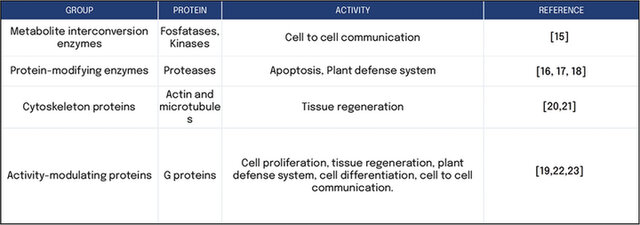
Table 2. Protein characterization of the secretome from Curcuma longa and assignment of functionality. Functions were annotated via PANTHER DB and GO-TERM analysis, supported by literature references
Comparison of both proteomes revealed notable distinctions: while C. longa secretome is more concentrated in metabolite interconversion enzymes, C. asiatica presents a more evenly distributed profile across diverse functional classes, including translation proteins and binding modulators. These differences may be translated to targeted applications in either skin repair or hair regeneration depending on the source.
Peptide characterization through advanced peptidomics
The CA peptidome identified 16,861 distinct peptides, primarily consisting of 75% peptides with 8-12 amino acids, with sequences of 10 amino acids being the most abundant length (Figure 3).
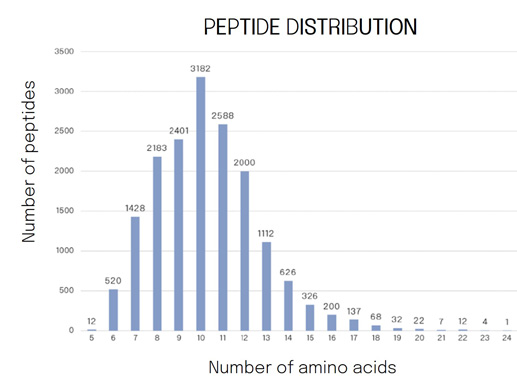
Figure 3. Peptide length distribution in the Centella asiatica secretome. Data were obtained through peptidomic analysis and plotted to show the frequency of peptides by amino acid length.
Similarly, for CL, the peptidomic analysis uncovered 34,339 different peptides, predominantly featuring peptides with 7-12 amino acids (75% of the total). Among these, sequences with a length of 10 amino acids were the most abundant (Figure 4).
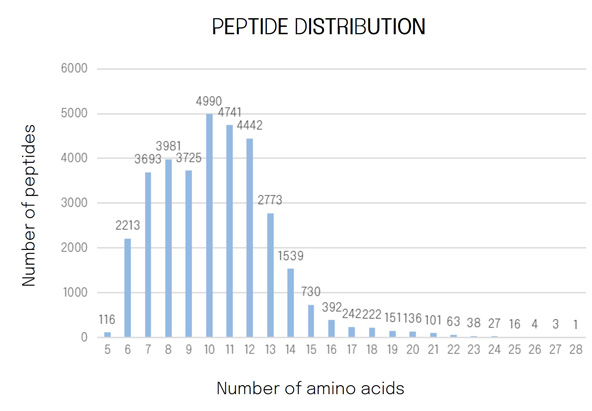
Figure 4. Peptide length distribution in the Curcuma longa secretome. Data were obtained through peptidomic analysis and plotted to show the frequency of peptides by amino acid length.
CA and CL secretomes exhibit a very similar distribution (Figures 3-4). However, the peptide diversity found in CL is significantly greater than that identified in CA, as we have identified nearly double the number of peptides.
To contextualize the relevance of these peptides in cosmetic science, we constructed a proprietary database named PEPVYT, compiling 87 peptides from scientific literature with validated cosmetic functions (e.g., anti-wrinkle, antioxidant, barrier-repair). A comparative screening of both secretomes against this database revealed 30 active peptides (34.48%) in C. asiatica and 40 (46%) in C. longa. These findings substantiate the functional potential of plant-derived secretomes as rich sources of naturally occurring biomimetic peptides for cosmetic applications.
In vitro assays
Evaluation of senescent markers in Centella asiatica secretome
The C. asiatica secretome was tested on human dermal fibroblasts (HDFs) under serum-starved conditions to assess its ability to stimulate key dermal matrix components. At a concentration of 0.01%, the treatment led to a 34% increase in pro-collagen I and a 26% rise in elastin synthesis versus untreated controls (Figure 5, A-B).
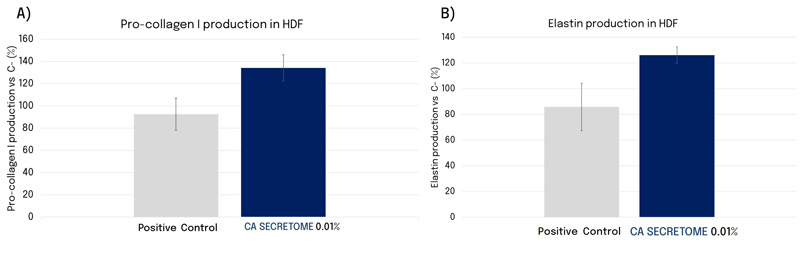
Figure 5 (A-B). The effect of Centella asiatica was 0.01% in HDF regarding pro-collagen I and elastin production compared to the positive control. A 72h treatment was performed. Pro-collagen I and elastin synthesis were measured by ELISA (triplicates) means. Positive control is the benchmark gold standard.
Evaluation of anti-hair loss activity in Curcuma longa secretome
Induction of Dermal Papilla cells Proliferation (HFDPC)
Human dermal papilla cells (HFDPCs), critical for hair cycling and anchoring, were treated with C. longa secretome at multiple concentrations. A relevantproliferation index of 177% was observed after 24 hours of treatment—surpassing classical growth factors such as FGF, VEGF, IGF, and outperforming industry gold standards (Figure 6).
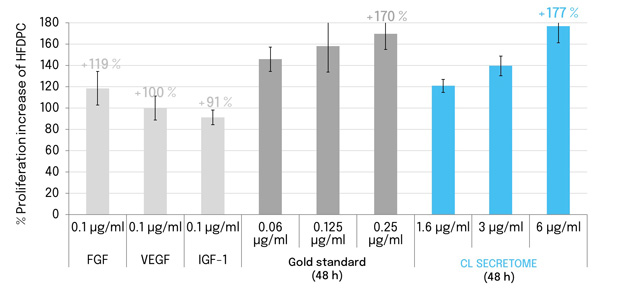
Figure 6. Proliferation index (%) on treated HFDPC normalized by non-treated cells. HFDPC were treated with different growth factors (FGF, IGF, and VEGF), gold standard, or the secretome of CL cell culture for 24 h and 48 h. Results are normalized to untreated control cells.
Furthermore, C. longa secretome significantly stimulated Insulin Growth Factor (IGF-1) production release in HFDPCs within 24 hours, with up to 115% increase relative to untreated cells. This growth factor is known to regulate follicular development and anagen phase induction, further highlighting the regenerative potential of the secretome (Figure 7).
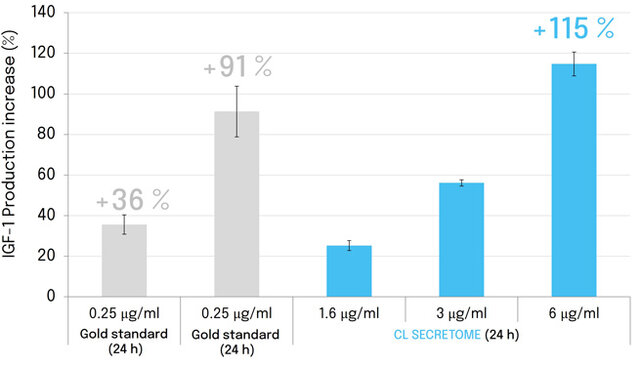
Figure 7. CL secretome effect on IGF-1 secretion of HFDPC after 24 h and 4 8h of treatment. Percentage of IGF-1 release in treated-HFDPC are normalized by non-treated cells.
In vivo assays
Anti-aging potential of the secretome of Centella asiatica
A placebo-controlled, double-blind clinical trial was conducted on women aged 51–59 to assess anti-aging efficacy of C. asiatica secretome. Firmness and elasticity were quantified using a Cutometer®. After 28 days, skin firmness improved by 36% and reached 46% by day 56. Elasticity demonstrate parallel gains of 21% (Figure 8, A-B).
To complement these biomechanical improvements, we calculated the Elasticity Rejuvenation Index (ERI) using Takema’s method. Compared to a young reference group (aged 20–25), ERI scores revealed a 12% rejuvenation effect after 28 days (equivalent to 3.6 years of visual age reduction), increasing to 14% after 56 days (4 years reduction).
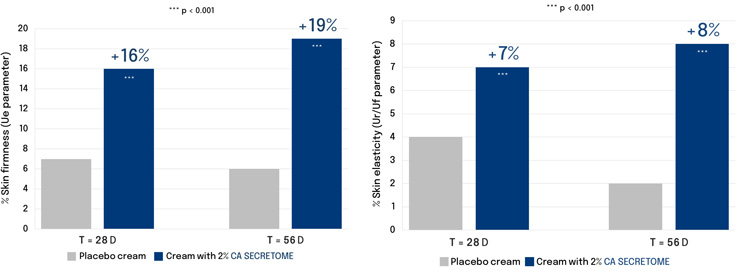
Figure 8 (A-B). A. Mean values of the parameter Ue reduction obtained with placebo and secretome of CA, at 28 and 56 days. B. Mean values of the parameter Ur/Uf increase obtained with placebo and CA secretome, at 28 and 56 days.
VISIA® imaging confirmed visible improvements across all facial complexion parametres —between days 28 and 56 (Table 3 and Figure 9), aligning with the biochemical improvements observed in vitro.
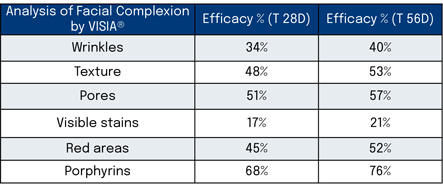
Table 3.Analysis of facial complexion using VISIA® and % efficacy facial complexion parameters, measured by means of a morphometric image analysis technique on standardized picture taken using VISIA®-CR (Canfield Imaging Systems Europe, Utrecht, Netherland). Quantitative evaluation was performed using morphometric image analysis to determine percentage changes in skin features.
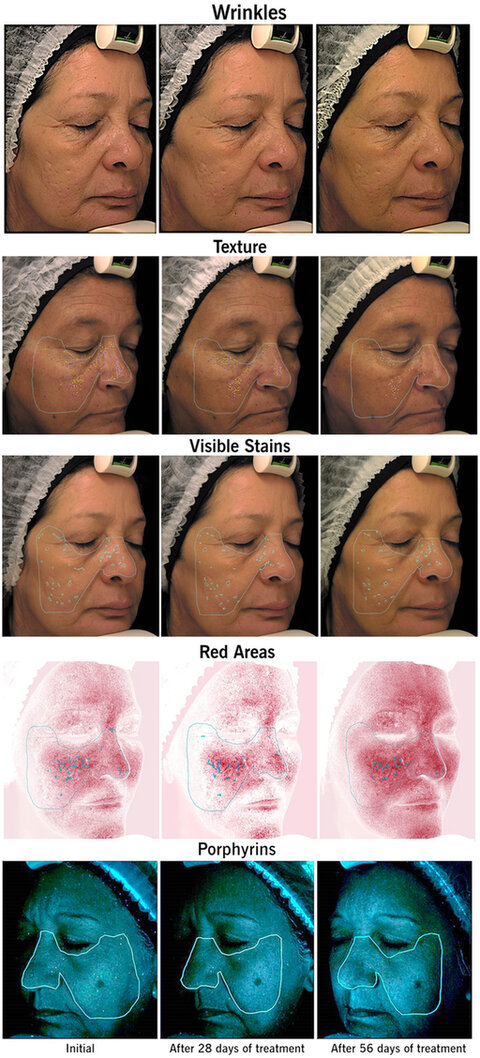
Figure 9. The analysis of facial complexion parameters is measured by means of a morphometric image analysis technique on a standardized picture taken using VISIA®-CR (Canfield Imaging Systems Europe, Utrecht, Netherland). Figure 9. The analysis of facial complexion parameters is measured by means of a morphometric image analysis technique on a standardized picture taken using VISIA®-CR (Canfield Imaging Systems Europe, Utrecht, Netherland).
Hair growth promotion by the secretome from Curcuma longa
In a 150-day double-blind clinical study involving subjects with various forms of alopecia, C. longa secretome (1%) demonstrated a statistically significant increase in hair density. Group comparisons were analyzed using paired t-tests or ANOVA, with p-values < 0.05 considered statistically significant. Quantified via TrichoScan® imaging, average density increased by 15.3% at 90 days and 17.3% at 150 days compared to baseline (Figure 10).
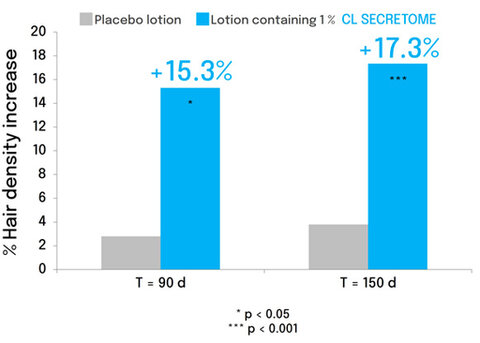
Figure 10. The regenerative efficacy of Curcuma longa was assessed by Microphotography (TrichoScan®; Tricholog GmbH, Freiburg im Breisgau Germany).
Moreover, visible improvements in lash and brow density were observed using the Global Eyelash and Eyebrow Assessment (GEA/GEBA) scales. Eyelash prominence improved by up to 200%, while eyebrow fullness increased by 50–100% after 120–150 days of application (Figure 11).
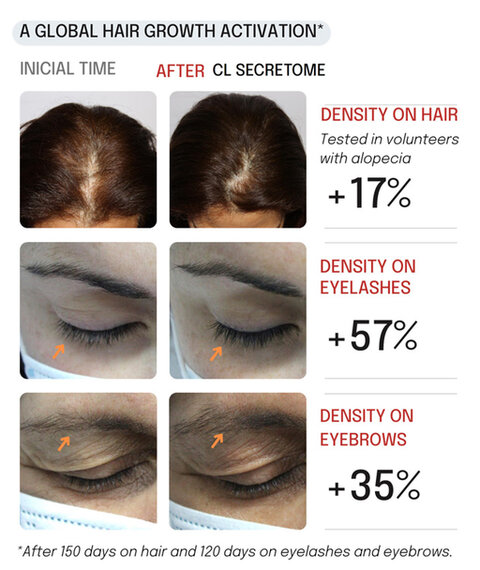
Figure 11. Global hair growth activation after 150 days of treatment on hair (Microphotography; TrichoScan®; Tricholog GmbH, Freiburg im Breisgau Germany) and 120 days of treatment on eyelashes and eyebrows.
Conclusion
The proteomics and peptidomics analyses of Centella asiatica and Curcuma longa secretomes reveal a substantial number of plant-derived proteins and peptides, exhibiting growth-factor-like activities that promote tissue regeneration and hair revitalization. There were diverse biological activities identified, including anti-aging, anti-inflammatory, and anti-wrinkle properties for Centella asiatica, as well as hair growth stimulation for Curcuma longa (18, 19, 20). Empirical evidence from both in vitro and in vivo studies supports the potential efficacy, while recognizing the associative nature of the observed effects, with Centella asiatica enhancing pro-collagen I and elastin production to improve skin firmness and elasticity, and Curcuma longa reactivating hair growth and delaying hair loss by extending the Anagen phase (21, 22). The observed biological activities, including analogous to growth factors effects, are supported by structural homology to known bioactive proteins and preliminary functional assays. Notably, metabolite interconversion enzymes represented the most abundant protein group, while peptides consisting of 10 amino acids were the most frequently observed length in the secretome. However, these activities are inferred rather than conclusively demonstrated, as no direct pathway activation studies were conducted to confirm mechanistic equivalence (23, 24). This research underscores the inherent biodiversity and synergy of plant peptides, highlighting the innovative potential of plant-derived peptides in the cosmetic industry as an alternative to synthetic peptides and animal-derived growth factors.
Although the peptidomic and proteomic profiling revealed promising bioactive molecules, further studies are needed to isolate and individually validate the activity of specific peptides. Additionally, the stability, formulation compatibility, and reproducibility of peptide content across batches require ongoing investigation.
Conclusion
The future of cosmetics lies in the continued evolution of holistic approaches which represents a transformative shift in the industry, merging scientific advancements, natural ingredients, and wellness principles. By understanding and embracing the interconnectedness of these elements, the cosmetics industry can cultivate products that not only enhance external beauty but also contribute to the overall well-being of individuals and the planet.
The interplay between beauty from within and topical cosmetics is the key for future products. The integration of biotechnology and green chemistry is revolutionizing cosmetic formulations, offering sustainable and biocompatible alternatives.
Developers can implement blockchain to trace the journey of ingredients from source to product. Nevertheless, the efficacy of the natural products should be scientifically proven. Marketers can communicate transparency as a brand value, and parallelly educate consumers by highlighting how specific ingredients contribute to radiant and healthy skin.
By embracing the synergy between these approaches and leveraging scientific advancements, the cosmetics industry can provide consumers with comprehensive beauty solutions that cater to both internal and external dimensions of beauty.
Surfactant Applications
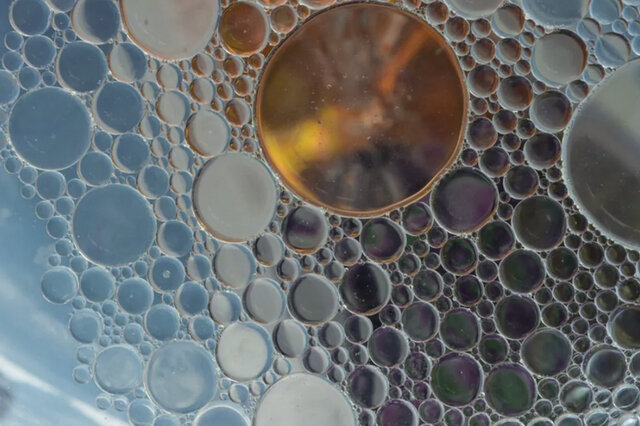
The application area lends itself particularly well to the use of AI. Active today in this area is the US company Potion AI (6). The company provides AI-powered formulation tools for beauty and personal care R&D. Their offerings include Potion GPT, next generation ingredient and formula databases and AI document processing. Potion’s work could have a significant impact on the entire surfactant value chain, from raw material suppliers to end consumers. By using their GPT technology, they can help target work toward novel surfactant molecules that have optimal properties for specific applications. By using their ingredient and formula databases, they can access and analyze a vast amount of data on surfactant performance, safety, and sustainability. By using their AI document processing, they can extract and organize relevant information from patents, scientific papers, and regulatory documents. These capabilities could enable Potion AI's customers to design and optimize surfactant formulations that are more effective, eco-friendly, and cost-efficient. A particularly interesting application for this type of capability is deformulation.
Deformulation is the process of reverse engineering a product's formulation by identifying and quantifying its ingredients. Deformulation can be used for various purposes, such as quality control, competitive analysis, patent infringement, or product improvement. However, deformulation can be challenging, time-consuming, and costly, as it requires sophisticated analytical techniques, expert knowledge, and access to large databases of ingredients and formulas.
AI can potentially enhance and simplify the deformulation process by using data-driven methods to infer the composition and structure of a product from its properties and performance. For example, AI can use machine learning to learn the relationships between ingredients and their effects on the product's characteristics, such as color, texture, fragrance, stability, or efficacy. AI can also use natural language processing to extract and analyze information from various sources, such as labels, patents, literature, or online reviews, to identify the possible ingredients and their concentrations in a product.
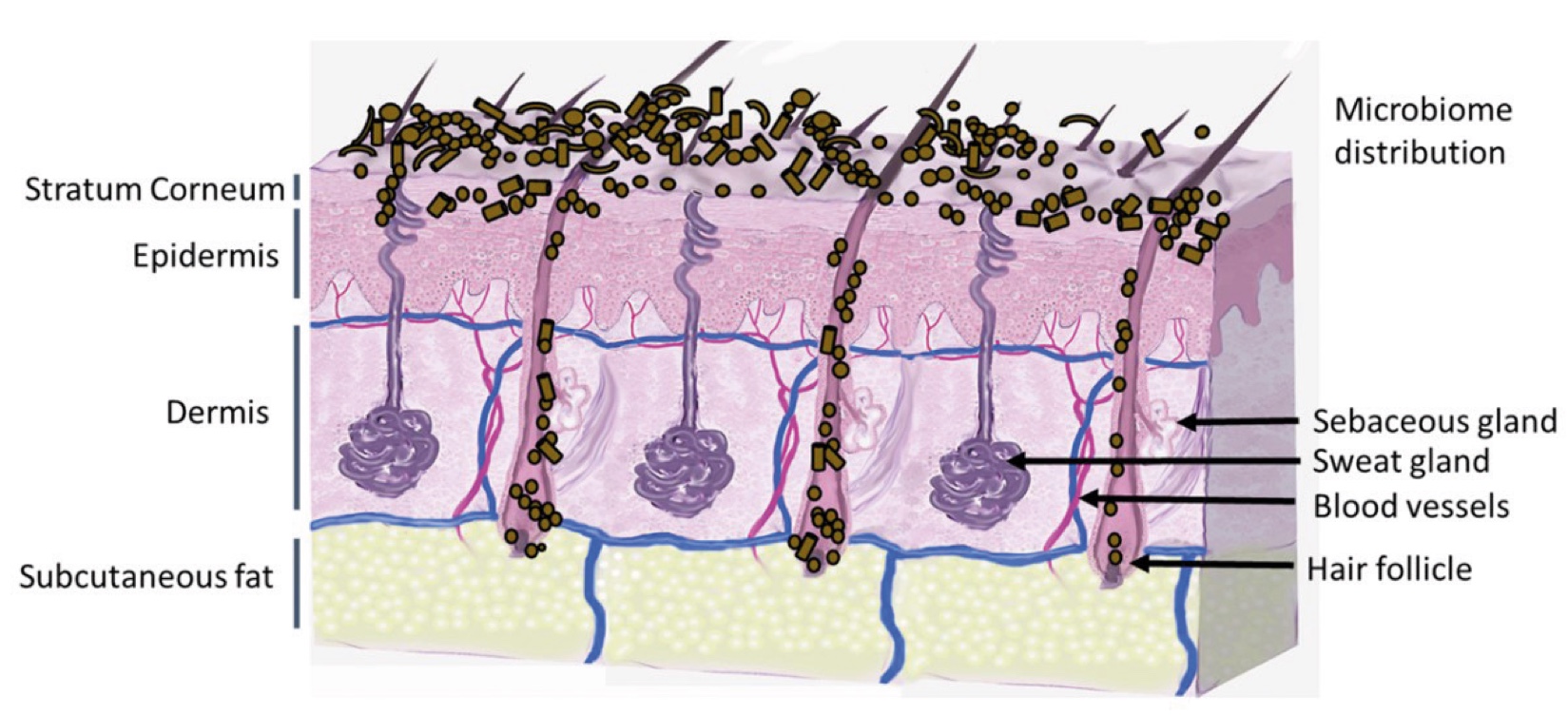
Figure 2. Skin Section with Microbiome. Most microorganisms live in the superficial layers of the stratum corneum and in the upper parts of the hair follicles. Some reside in the deeper areas of the hair follicles and are beyond the reach of ordinary disinfection procedures. There bacteria are a reservoir for recolonization after the surface bacteria are removed.
References and notes
- Lo, J.H., Chen, T.T., Production of bioactive recombinant human Eb-peptide of pro-IGF-I and identification of binding components from the plasma membrane of human breast cancer cells (MDA-MB-231), Exp. Cell. Res., 362 (2018) Jan, 235-243.
- Xiong, R., Chen, J., Chen, J., Secreted expression of human lysozyme in the yeast Pichia pastoris under the direction of the signal peptide from human serum albumin, Biotechnol. Appl. Biochem., 51 (2008) Nov, 129-134.
- Murphy, E., Smith, S., De Smet, I., Small Signaling Peptides in Arabidopsis Development: How Cells Communicate Over a Short Distance, Plant Cell, 24 (2012) Aug, 3198-3217.
- Oh, E., Seo, P.J., Kim, J., Signaling Peptides and Receptors Coordinating Plant Root Development, Trends Plant Sci., 23 (2018) Jan, 337-351.
- Vasil, I. K., Vasil, V., Redway, F., Plant regeneration from embryogenic calli, cell suspension cultures and protoplasts of Triticum aestivum L.(Wheat), in: Nijkamp, H.J.J., Van Der Plas, L.H.W., Van Aartrijk, J. (Eds.), Progress in Plant Cellular and Molecular Biology. Current Plant Science and Biotechnology in Agriculture, 9, Springer, Dordrecht, The Netherlands, pp. 33-37.
- Vasil, V., Vasil, I.K., The Ontogeny of Somatic Embryos of Pennisetum americanum (L.) K. Schum. I. In Cultured Immature Embryos, Bot. Gazette, 143 (1982) Dec, 454-465.
- Jones, T.J, Rost, T.L., The Developmental Anatomy and Ultrastructure of Somatic Embryos from Rice (Oryza sativa L.) Scutellum Epithelial Cells, Bot. Gazette, 150 (1989) Mar, 41-49.
- Xie, H., Zhao, W., Li, W., Zhang, Y., Hajný, J., Han, H., Small signaling peptides mediate plant adaptions to abiotic environmental stress, Planta, 255 (2022) Feb, article 72.
- Walton, J. D., Luo, H., & Hallen-Adams, H. (2012). Chapter Four – Ribosomally encoded cyclic peptide toxins from mushrooms. In D. A. Hopwood (Ed.), Methods in Enzymology (Vol. 516, pp. 63–77). Academic Press. https://doi.org/10.1016/B978-0-12-394291-3.00025-3”
- Ngoc, L.T.N., Moon, J-Y., Lee, Y-C., Insights into Bioactive Peptides in Cosmetics, Cosmetics, 10 (2023) Aug, article 111.
- Mergner, J. et al., Mass-spectrometry-based draft of the Arabidopsis proteome, Nature, 579 (2020) Mar, 409–414.
- Takahashi, F., Hanada, K., Kondo, T., Shinozaki, K., Hormone-like peptides and small coding genes in plant stress signaling and development, Curr. Opin. Plant Biol., 51 (2019) Oct, 88-95.
- Woo, D.U. et al., RiceProteomeDB (RPDB): a user-friendly database for proteomics data storage, retrieval, and analysis, Sci. Rep., 14 (2024) Feb, article 3671.
- Halperin, W., Jensen, W.A., Ultrastructural changes during growth and embryogenesis in carrot cell cultures, J. Ultrastruct. Res., 18 (1967) May, 428-443.
- Nguyen, L.K. et al., Signalling by protein phosphatases and drug development: a systems‐centred view, FEBS J., 280 (2013) Jan, 751–765.
- Salvesen, G.S. et al., Protease signaling in animal and plant‐regulated cell death, FEBS J., 283 (2016) Jul, 2577–2598.
- Balakireva, A.V. et al., Indispensable role of proteases in plant innate immunity, Int. J. Mol. Sci., 19 (2018) Feb, article 629.
- Toriseva, M. et al., Proteinases in cutaneous wound healing, Cell. Mol. Life. Sci., 66 (2009) Jan, 203–224.
- Doma, E. et al., EGFR-ras-raf signaling in epidermal stem cells: roles in hair follicle development, regeneration, tissue remodeling and epidermal cancers, Int. J. Mol. Sci., 25 (2013) Sep, 19361–19384.
- Abreu-Blanco, M.T. et al., Cytoskeleton responses in wound repair, Cell. Mol. Life Sci., 69 (2012) Aug, 2469–2483.
- Kopecki, Z., Cowin, A.J., The role of actin remodelling proteins in wound healing and tissue regeneration. In: Wound Healing–New Insights into Ancient Challenge, IntechOpen, Rijeka, Croatia, 2016, 1st Edition, pp. 133-154.
- Drosten, M. et al., Ras signaling is essential for skin development, Oncogene, 33 (2014) May, 2857–2865.
- Cao, H., Glazebrook, J., Clarke, J. D., Volko, S., & Dong, X., The Arabidopsis NPR1 gene that controls systemic acquired resistance encodes a novel protein containing ankyrin repeats, Cell., 88 (1997) Jan, 57-63.
- Scieglinska, D. et al., Heat shock proteins in the physiology and pathophysiology of epidermal keratinocytes, Cell Stress Chaperones, 24 (2019) Nov, 1027–1044.
